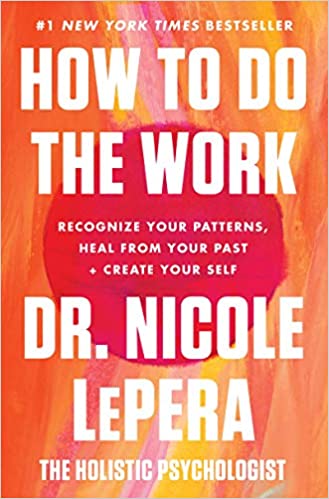How to Do the Work — Book Summary
Introduction
Nicole LePera is a psychologist (she's known as the holistic psychologist) who trained in clinical psychology at Cornell University and The New School of Social Research. She wrote How To Do The Work as a sort of manifesto to create a more vibrant life for yourself and practice self-healing.
Interesting quotes from the book
You may label these thoughts as 'you', but they are not you. You are the thinker of your thoughts, not the thoughts themselves.
— Nicole LePera, How to Do the Work
I discovered that our genes are not destiny and that in order to change, we have to become consciously aware of our habits and thought patterns, which have been shaped by the people we care for most.
— Nicole LePera, How to Do the Work
The evolution of man is the evolution of his consciousness. With objective consciousness it is possible to see and feel the unity of everything.
— Nicole LePera, How to Do the Work
Summary of the book How to Do the Work
The book begins with a lengthy introduction of what Holistic Psychology is, with Nicole LePera narrating her personal experiences to show her journey and her eventual discovery of her field and the concept of holistic psychology.
Holistic Psychology draws from the assertion that mental and physical health are connected and intricately linked. Holistic Psychology addresses all aspects of the person (mind, body, and soul), and according to the author, has some basic tenets, which are:
- Healing is a daily event. You must daily go inward to be healed, actively making choices that will help the healing.
- Choice is important because choice enables healing.
- Practical and approachable tools and approaches to change make the change easier and more constant.
- Taking responsibility for your mental health. This is incredibly empowering and makes handling any problems easier.
Deliberately making a choice beneficial to you, even if it seems impossible or grim, can completely change the trajectory of your life for the better.
The next chapter talks about how we all think so much that many assume that the constant barrage and chattering of thoughts is the 'real you,' or the Inner Self. However, this is not so. The thoughts are just thoughts. We ourselves are the thinkers of the thoughts. We ourselves are the 'real you,' not the thoughts.
To truly implement any positive changes, we must be 'conscious' of ourselves. We must recognize our thoughts and the fact that we're thinking them before we can decide to change them.
The third chapter talks about trauma. The author argues that trauma should have a wider definition than just physical or extreme emotional trauma. It should include spiritual trauma and a wider range of emotional trauma. In essence, trauma should include experiencing situations that place people into a 'state of relative helplessness'.
Childhood trauma is caused by different factors. For instance, a parent who denies his child's reality, who does not see or hear the child, who lives vicariously through the child, etc.
We all carry some sort of trauma or the other. It is how we react to its effects, how we respond to it in general that determines the imprint it makes. Recognizing the trauma and the coping mechanisms we have formed from it helps us better manage the trauma.
The next chapter builds on the previous in an interesting way, discussing how the effects of trauma don't just affect us mentally but also physically as well. It is the cause of some of the illnesses that plague us. This physical dysfunction boils down to one word: stress, which is a state that upsets homeostasis (mental, emotional, and physical balance). This then causes several disruptions to normal bodily processes. It deregulates our nervous system and causes a host of problems to the body.
The next chapter links the two previous chapters together, making it clear that the body and mind were intricately connected, and one often affects the other greatly. How a person's body reacts can let you know his state of mind.
The brain/mind affecting the body is called the 'top-down' effect by the author. Meditation was a top-down practice, where the mind is calmed, which then affects the body positively.
'Bottoms-up' effect is vice-versa, where better bodily processes lead to a better mental state. Thus, things like eating healthy, sleeping well, playing, singing, movement/exercise, help to make us generally happier.
Belief is a core part of our being, and they are very powerful. Beliefs are practiced thoughts grounded in lived experience, and they are built up over years of thought patterns and require both interior and exterior validation to thrive.
When a belief is increasingly validated, it becomes a core belief. To truly understand and change these beliefs, it is necessary to discover their connection with your inner child.
To understand the inner child, we must first understand the attachment theory. The attachment theory was formed using studies on infant behavior when their mothers left the room, and from these studies, it is deducible that there are four attachment styles: secure, anxious, avoidant, and disorganized-disoriented.
These styles also show in the way our inner child behaves because the wounds we carry into adulthood are more often than not, attachment-based. When our inner child is wounded, it affects our behavior in adulthood, our reaction to things, and so on.
To heal the inner child's wounds, we must first acknowledge that you have an inner child, acknowledge that the inner child is wounded. But also acknowledge that though your inner child is there, it is only a part of you; it is not your essential, intuitive Self.
The next chapter talks about the ego. It calls the ego 'the great protector of the inner child'. It is the 'I' identity, for instance, I'm smart, I'm shy, etc. It is our self-worth.
The ego is constantly defensive and usually brooks no counter-opinion or considers other people. To temper the effects our egos have on us, we must be aware of the ego. The book then gives some step-by-step guides on how to recognize the ego.
Being aware of the ego creates a space of awareness that will allow you to make choices beyond knee-jerk ego reactivity.
The book then talks about trauma bonding and relationship to boundaries as ways of showing how childhood experiences shape the future.
Re-parenting can help, ensuring that people develop emotional maturity to help them go through life in peace and security.
Key Lessons from the Book
Lesson 1: Acknowledging everything about us is a great way to begin our healing process.
Healing is not going to happen overnight. Sure! But, a great way to start on your walk to healing is acknowledging and accepting both the negatives and positives about ourselves.
Lesson 2: Trauma is wider-ranging than is taught.
Trauma reaches far into the deepest recesses of us to destroy. It's not as simple as people make it seem. It goes beyond one part of our lives, to maybe every part of our lives.
Lesson 3: Although childhood experiences essentially shape us, it is possible to re-parent ourselves and get better out of life.
Our childhood experiences shape who we are, however, we can look into ourselves and change.
Review of the book How to Do the Work
I found the book refreshing. I will always love books that delve into the depth of the human mind. While I have my reservations about holistic psychology, Le Pera does a great job of selling her points!
Conclusion
I wouldn't recommend this to just women, I think this book is for everyone that is searching for inner healing. However, I think the people that would really learn from this book might be those who don't exactly think they have a traumatic history. I think it's a good place to start though!
Don't miss the other book summaries on SunInMe.org

